2023 July 21
Cheryl Hoyle photographed two butterflies in Beacon Hill Park, July 20.
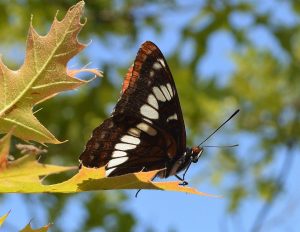 Lorquin’s Admiral Limenitis lorquini (Lep.: Nymphalidae)
Lorquin’s Admiral Limenitis lorquini (Lep.: Nymphalidae)
Cheryl Hoyle
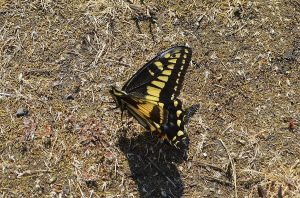 Anise Swallowtail Papilio zelicaon (Lep.: Papilionidae)
Anise Swallowtail Papilio zelicaon (Lep.: Papilionidae)
Cheryl Hoyle
2023 July 21
Cheryl Hoyle photographed two butterflies in Beacon Hill Park, July 20.
 Lorquin’s Admiral Limenitis lorquini (Lep.: Nymphalidae)
Lorquin’s Admiral Limenitis lorquini (Lep.: Nymphalidae)
Cheryl Hoyle
 Anise Swallowtail Papilio zelicaon (Lep.: Papilionidae)
Anise Swallowtail Papilio zelicaon (Lep.: Papilionidae)
Cheryl Hoyle
2023 July 20 evening
Below we show a male Rusty Tussock or Vapourer Moth. The female has no functional wings. The caterpillar from which this moth was reared is shown on July 2. The insect spent less than three weeks in the pupal stage. Tussock moths (Lymantriinae) are named for the characteristic tussocks of hairs on the caterpillars. I don’t know for sure the origin of the name “Vapourer” moth, unless it be for the copious pheromones emitted by the flightless female.
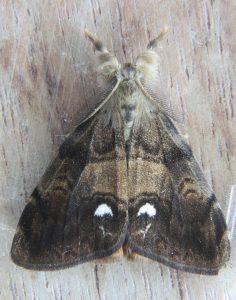 Rusty Tussock or Vapourer Orgyia antiqua
Rusty Tussock or Vapourer Orgyia antiqua
(Lep.: Erebidae – Lymantriinae)
Jeremy Tatum
2023 July 20
Here is a Pearly Underwing Moth Peridroma saucia. The caterpillar was shown on June 28 evening. The pupal stage lasted only three weeks.
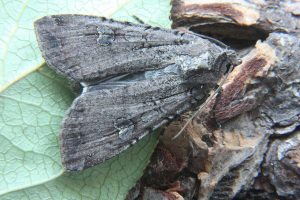 Peridroma saucia (Lep.: Noctuidae) Jeremy Tatum
Peridroma saucia (Lep.: Noctuidae) Jeremy Tatum
Val George writes: This long-horned beetle (Centrodera spurca) was on the wall of my Oak Bay house yesterday, July19. It was trapped there because one of its hind legs was caught in the spider thread visible in the photo.
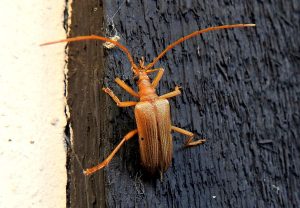 Yellow Douglas-fir Borer Centrodera spurca (Col.: Cerambycidae) Val George
Yellow Douglas-fir Borer Centrodera spurca (Col.: Cerambycidae) Val George
Jochen Möhr sends a photograph of a curious moth from Metchosin. It seems to be a male Malacosoma – but it has none of the usual transverse lines of our two familiar species. I can only think (writes Jeremy Tatum) that it is an unusual “ab” (aberration) of one of the two – but which one, I cannot tell.
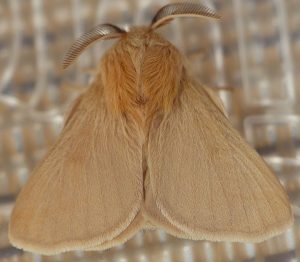 Malacosoma sp. (Lep.: Lasiocampidae) Jochen Möhr
Malacosoma sp. (Lep.: Lasiocampidae) Jochen Möhr
2023 July 19 evening
Aziza Cooper writes: On July 16, I visited McIntyre Reservoir and found this dragonfly and moth. I saw about 15 Cabbage Whites and one Western Tiger Swallowtail butterfly.
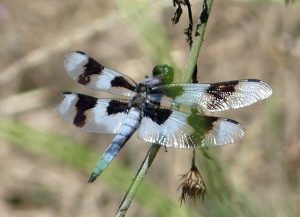 Eight-spotted Skimmer Libellula forensis (Odo.: Libellulidae)
Eight-spotted Skimmer Libellula forensis (Odo.: Libellulidae)
Aziza Cooper
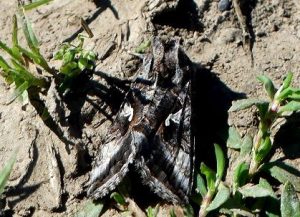 Autographa californica (Lep.: Noctuidae – Plusiinae) Aziza Cooper
Autographa californica (Lep.: Noctuidae – Plusiinae) Aziza Cooper
Aziza continues: On July 17, at Mount Tolmie about 6:30 pm, there were four Painted Ladies and one Red Admiral.
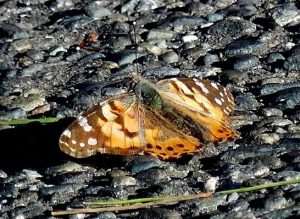 Painted Lady Vanessa cardui (Lep.: Nymphalidae) Aziza Cooper
Painted Lady Vanessa cardui (Lep.: Nymphalidae) Aziza Cooper
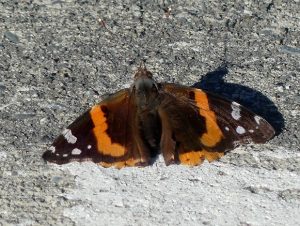 Red Admiral Vanessa atalanta (Lep.: Nymphalidae) Aziza Cooper
Red Admiral Vanessa atalanta (Lep.: Nymphalidae) Aziza Cooper
On July 18, at Island View Beach, Aziza saw an Anise Swallowtail, 3 Western Tiger Swallowtails, and various Cabbage Butterflies and skippers at Island View Beach park. On the First Nations Land there was a Grey Hairstreak and a black and white grasshopper.
For the identification of the grasshopper, we are grateful to James Miskelly, who writes: This one is Trimerotropis pallidipennis. They live in dry grasslands in interior BC, but in our area they’re strongly associated with coastal sand.
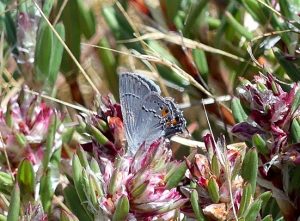 Grey Hairstreak Strymon melinus (Lep.: Lycaenidae) Aziza Cooper
Grey Hairstreak Strymon melinus (Lep.: Lycaenidae) Aziza Cooper
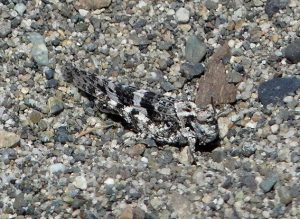 Trimerotropis pallidipennis (Orth.: Acrididae) Aziza Cooper
Trimerotropis pallidipennis (Orth.: Acrididae) Aziza Cooper
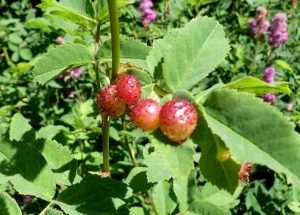 Rose Leaf Gall Diploletis polita (Hym.: Cynipidae) Aziza Cooper
Rose Leaf Gall Diploletis polita (Hym.: Cynipidae) Aziza Cooper
On July 19 Aziza reports two Red Admirals, three Painted Ladies, two Anise Swallowtails and a Pale Tiger Swallowtail from Mount Douglas, and Jeremy Tatum reports two Red Admirals and two Painted Ladies from Mount Tolmie.
Western Tiger Swallowtails and Lorquin’s Admirals are still being seen generally.
2023 July 19 morning
Jochen Möhr has photographed several Malacosoma moths in Metchosin. We have two species; M. californicum and M. disstria. The caterpillars are quite distinct, but the adult moths can be difficult to distinguish. I believe (writes Jeremy Tatum) that all five of the moths below may be M. californicum. However, I have labelled two of them as “Probably” M. californicum, to indicate that I am not completely certain, and there is a (small) possibility that these may be M. disstria.
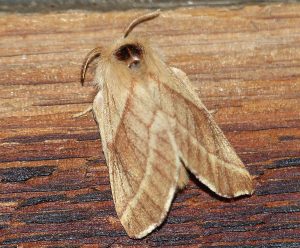 Malacosoma californicum (Lep.: Lasiocampidae) Jochen Möhr
Malacosoma californicum (Lep.: Lasiocampidae) Jochen Möhr
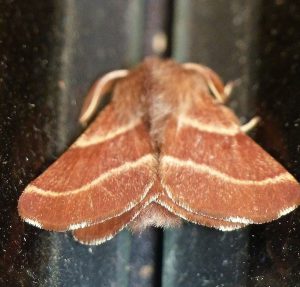 Malacosoma californicum (Lep.: Lasiocampidae) Jochen Möhr
Malacosoma californicum (Lep.: Lasiocampidae) Jochen Möhr
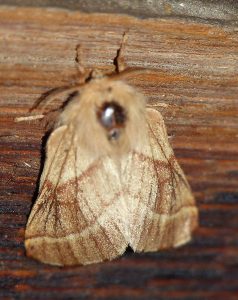 Malacosoma californicum (Lep.: Lasiocampidae) Jochen Möhr
Malacosoma californicum (Lep.: Lasiocampidae) Jochen Möhr
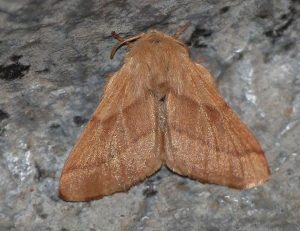 Probably Malacosoma californicum (Lep.: Lasiocampidae)
Probably Malacosoma californicum (Lep.: Lasiocampidae)
Jochen Möhr
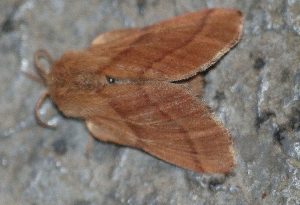 Probably Malacosoma californicum (Lep.: Lasiocampidae)
Probably Malacosoma californicum (Lep.: Lasiocampidae)
Jochen Möhr
Also shown by Jochen are an upperside and an underside of the White Satin Moth Leucoma salicis.
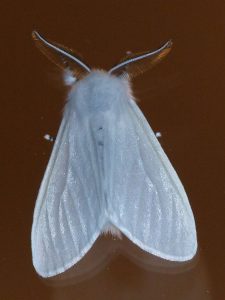 Leucoma salicis (Lep.: Erebidae – Lymantriinae) Jochen Möhr
Leucoma salicis (Lep.: Erebidae – Lymantriinae) Jochen Möhr
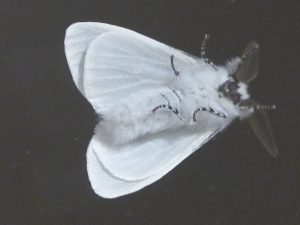 Leucoma salicis (Lep.: Erebidae – Lymantriinae) Jochen Möhr
Leucoma salicis (Lep.: Erebidae – Lymantriinae) Jochen Möhr
Jochen sends pictures of two more moths, one of which is easy – the other not so!
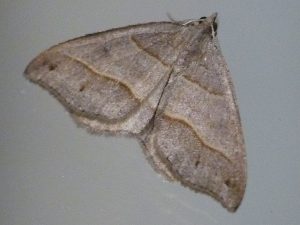 Macaria lorquinaria (Lep.: Geometridae) Jochen Möhr
Macaria lorquinaria (Lep.: Geometridae) Jochen Möhr
Libby Avis writes, of the moth below: This moth is a Crambidae, subfamily Scopariinae for sure, but they’re hard to get to species. Most likely a Scoparia or a Eudonia. Best guess (only a guess, not an ID!) is Eudonia commortalis. [Jeremy Tatum ventures: Libby is right to be cautious – though her “guess” looks like a pretty good “guess” to me!]
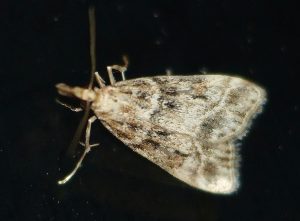 Crambid moth (Lep.: Crambidae – Scopariinae) Jochen Möhr
Crambid moth (Lep.: Crambidae – Scopariinae) Jochen Möhr